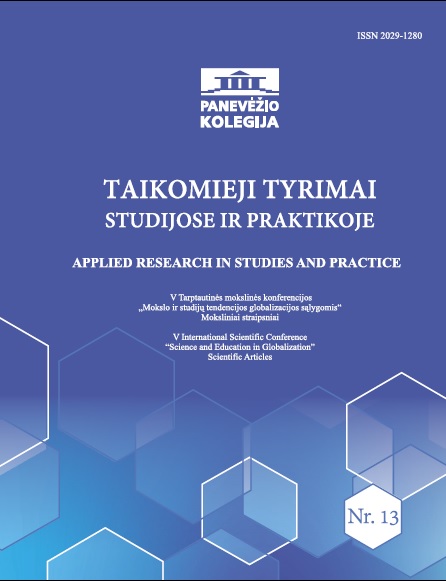KOSMETOLOGŲ/GROŽIO TERAPEUTŲ VEIKLA KLIENTĖS NĖŠTUMO IR ŽINDYMO LAIKOTARPIU
THE ACTIVITY OF BEAUTITION/BEAUTY THERAPIST DURING CLIENTS‘ PREGNANCY AND BREAST-FEEDING
Author(s): Gražina Šniepienė, Simona Kaminskaitė, Kristina LetkauskaitėSubject(s): Health and medicine and law
Published by: Panevėžio kolegija
Keywords: cosmetic procedures; manual and device procedures; pregnancy and lactation; contraindications;
Summary/Abstract: Research background. The article analyzes the safe choice of cosmetic procedures and cosmetics during pregnancy and breast-feeding. During pregnancy women often face with skin problems such as pigmentation, rashes, telangiectasia and other body changes such as enlarged veins, striae, which occur due to hormone unstability during pregnancy. The women who visited cosmetology salons during pregnancy may keep on doing it. However, not all cosmetic procedures are recommended. A cosmetologist/beauty therapeutist may perform relaxing, not causing discomfort, non-aggressive procedures which do not have harmful effect on fetus. It is not recommended during breast-feeding to carry out heating or cosmetic procedures which have a stimulating effect in breast or armpit area. It is not recommended during pregnancy or breast-feeding period to apply cosmetic substances which get into systematic blood circulation and are susceptible to accumulate in the body, able to permeate a placental barrier and get into mother‘s milk during lactation period. An adverse effect on infant and mother may have ingredients of cosmetic product ingredients: some preservatives and antimicrobial, fragrant substances, surfactants, UV filters and other substances.The aim of the study was to analyze the activity of beauticians/beauty therapists during clients‘ pregnancy and breast-feeding. The studies‘ problem is based on the problematic issues: what are the safest cosmetic procedures and cosmetics for women during pregnancy and breast-feeding? What are the activities of beauticians/beauty therapists during clients‘ pregnancy and breast-feeding? Subjets and methods. Scientific and educational literature systematization and analysis; interview; Qualitative analysis of the content. For data collection is selected individual interview (survey verbal) method. The study participants are given a semi-structured questionnaire, which consists of 3 main questions: What professional experience in serving customers during pregnancy and breast-feeding? What kind of cosmetic treatments and materials recommended during pregnancy and breast-feeding? What kind of cosmetic treatments and materials are not recommended during pregnancy and breast-feeding?The study surveyed 25 study participants. Study participants were choosen from cosmetologists/beauty therapists who have at least 5 years of work experience in providing beauty services. Also, study participants had to be multidisciplinary, it is carried out facial and body cosmetic treatments as well as face and body treatments using cosmetic devices. The study condition was that study participants would have experience providing beauty services for pregnant and breast-feeding customers. The survey was conducted in the workplace of the study participants. Survey average duration was 45 minutes.Outcomes of the research. The study showed that during pregnancy cosmetology specialists perform the following treatments in the facial area: basic facial care, facial cleansing procedures, massages and the procedures during which galvanic current and microabrasion are applied. Cosmetology specialists carry out basic facial, ultrasound, iontophoresis, radiofrequency therapy and massages for breast-feeding women in facial area. The treatments which cosmetologists/beauty therapists recommended during pregnancy were massages, depilation and body wrap procedures. For clients during breast-feeding period the cosmetologists/beauty therapists performed depilation, massages and body wrap procedures in body area except breast area. The study showed that is not recommended to perform hard cosmetic procedures with ultrasound, miostimulation, electroplating, radiofrequency therapy, dermabrasion during pregnancy. Also beauticians/beauty therapist should not perform body wraps, either procedures causing discomfort such as hair removal (eg. wax, sugar paste depilation) and chemical peels for pregnant and breast-feeding women.For women during pregnancy and breast-feeding period the cosmetologists/beauty therapists apply hyaluronic acid, collagen, vitamin preparations, except retinol, vegetable extracts (azulene, allantoin, aloin), vegetable oils, natural fragrant substances and UV filters.The study showed that for pregnant and breast-feeding women is important not to choose cosmetics that contain preservatives and antimicrobial substances (parabens, triclosan, phenoxyethanol, formaldehyde), synthetic fragrances, surfactants (especially sodium lauryl sulphate) and chemical UV filters which can get into the mother's blood and/or milk. Stated conclusions: according to the study rezults, the reaserch participants identified the recommended and not recommended cosmetic procedures and cosmetics for the clients during pregnancy and breast-feeding period, but it was discovered some inconsistencies with the scientific literature. It showed a lack of knowledge in this area by some professionals. The study participants' opinion about the recommended and not recommended cosmetic procedures and cosmetics for pregnant and breast-feeding clients slightly parted. The results also revealed that there is missing cooperation of beauticians/beauty therapists with specialists from other fields.After study the following recommendations are presented: for safer work with pregnant and breast-feeding women and seeking to improve the quality of performed procedures it is recommended for cosmetologists/beauty therapists to collaborate and consult with other specialists – family doctors, gynecologists, dermatovenereologists and pharmacists.
Journal: Taikomieji tyrimai studijose ir praktikoje
- Issue Year: 13/2017
- Issue No: 1
- Page Range: 72-84
- Page Count: 13
- Language: Lithuanian

